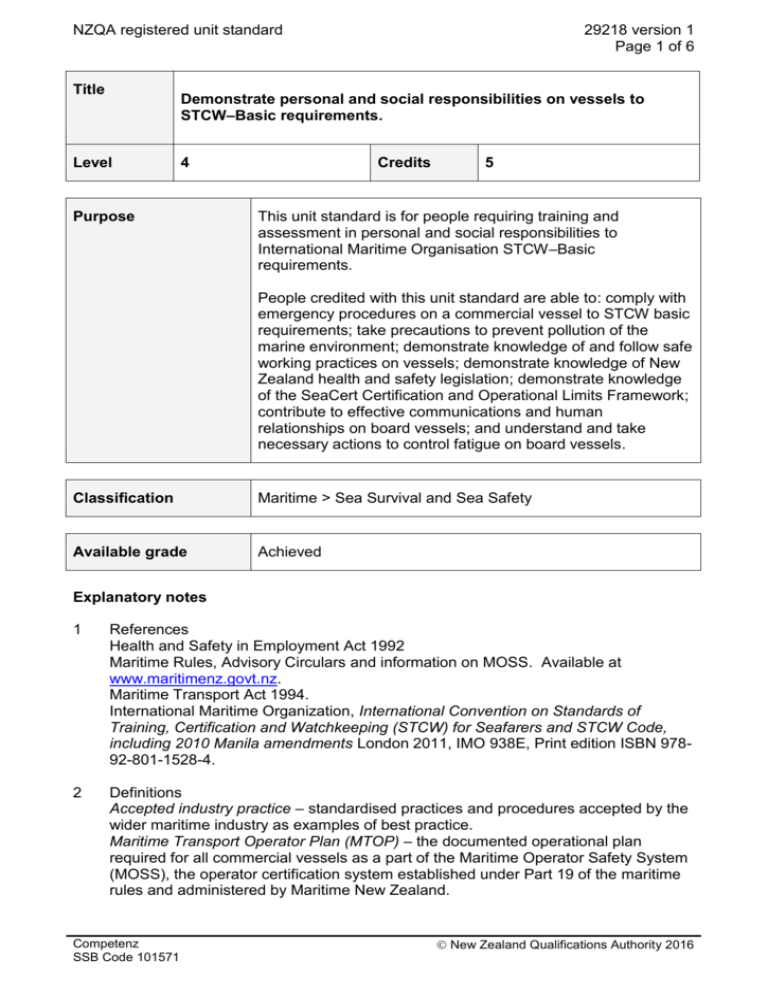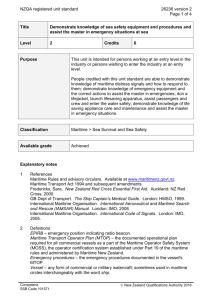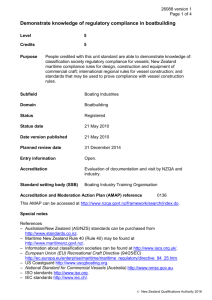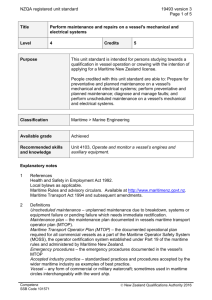Word - NZQA
advertisement

NZQA registered unit standard Title 29218 version 1 Page 1 of 6 Demonstrate personal and social responsibilities on vessels to STCW–Basic requirements. Level 4 Purpose Credits 5 This unit standard is for people requiring training and assessment in personal and social responsibilities to International Maritime Organisation STCW–Basic requirements. People credited with this unit standard are able to: comply with emergency procedures on a commercial vessel to STCW basic requirements; take precautions to prevent pollution of the marine environment; demonstrate knowledge of and follow safe working practices on vessels; demonstrate knowledge of New Zealand health and safety legislation; demonstrate knowledge of the SeaCert Certification and Operational Limits Framework; contribute to effective communications and human relationships on board vessels; and understand and take necessary actions to control fatigue on board vessels. Classification Maritime > Sea Survival and Sea Safety Available grade Achieved Explanatory notes 1 References Health and Safety in Employment Act 1992 Maritime Rules, Advisory Circulars and information on MOSS. Available at www.maritimenz.govt.nz. Maritime Transport Act 1994. International Maritime Organization, International Convention on Standards of Training, Certification and Watchkeeping (STCW) for Seafarers and STCW Code, including 2010 Manila amendments London 2011, IMO 938E, Print edition ISBN 97892-801-1528-4. 2 Definitions Accepted industry practice – standardised practices and procedures accepted by the wider maritime industry as examples of best practice. Maritime Transport Operator Plan (MTOP) – the documented operational plan required for all commercial vessels as a part of the Maritime Operator Safety System (MOSS), the operator certification system established under Part 19 of the maritime rules and administered by Maritime New Zealand. Competenz SSB Code 101571 New Zealand Qualifications Authority 2016 NZQA registered unit standard 29218 version 1 Page 2 of 6 Operating procedures – the safe operating procedures documented in the vessel's Marine Transport Operator Plan as well as any undocumented standard operating procedures for that vessel. STCW – the International Maritime Organisation’s convention on the Standards of Training, Certification and Watchkeeping for Seafarers. The convention establishes basic requirements on training, certification and watchkeeping for seafarers on an international level. Vessel – any form of commercial or military watercraft; sometimes used in maritime circles interchangeably with the word ship. 3 This unit standard includes outcomes and evidence requirements that cover the following training requirements of STCW Code, Table A-VI/1-4, Specification of minimum standard of competence in personal safety and social responsibility: – Comply with emergency procedures – Take precautions to avoid pollution of the marine environment – Observe safe working practices – Contribute to effective communications on board ship – Contribute to effective human relationships on board ship – Understand and take necessary actions to control fatigue 4 Competency may be demonstrated using simulated scenarios. Outcomes and evidence requirements Outcome 1 Comply with emergency procedures on a commercial vessel to STCW basic requirements. Range fire, collision, foundering, ingress of water. Evidence requirements 1.1 Contingency plans for response to emergencies are described in accordance with the vessels operating procedures. 1.2 Emergency signals and specific duties allocated to crew members are described in accordance with the vessel’s operating procedures. 1.3 Actions to take on discovering potential emergencies are described in accordance with the vessels operating procedures. 1.4 Information given on raising the alarm is in accordance with accepted industry practice. 1.5 The value of training and drills, and the need to be ready for any emergency requiring ship abandonment is explained in terms of maintenance safety of persons and vessel. Outcome 2 Take precautions to prevent pollution of the marine environment Competenz SSB Code 101571 New Zealand Qualifications Authority 2016 NZQA registered unit standard 29218 version 1 Page 3 of 6 Evidence requirements 2.1 The impact of operational or accidental pollution is explained in terms of the adverse effects on the marine environment 2.2 Basic environmental protection procedures are followed in accordance with maritime rules or regulations. Range refuelling operations, sewage and rubbish collection and disposal. 2.3 Marine environment is described in terms of its complexity and diversity. 2.4 Organizational procedures designed to safeguard the marine environment are implemented in accordance with vessel operating procedures. Outcome 3 Demonstrate knowledge of and follow safe working practices on vessels in accordance with accepted industry practice. Evidence requirements 3.1 The importance of adhering to safe working practices on board is explained in general and for candidates own expected on board context. 3.2 Enclosed spaces are defined and identified and precautions to take prior to entering an enclosed space are described for typical on board scenarios. 3.3 Atmospheric and non-atmospheric hazards associated with confined spaces are stated. 3.4 Safety and protective devices available to protect against potential hazards are identified for two typical on board scenarios. 3.5 Safe working practices are followed and appropriate safety and protective equipment is used. 3.6 Measures for the prevention of accidents and maintenance of occupational health on ships and in port are identified. Range hazard identification and reporting system, hazard management, near-miss reporting, accident investigation. Outcome 4 Demonstrate knowledge of New Zealand health and safety legislation. Evidence requirements 4.1 Responsibilities of employers under the HSE Act are described. Range Competenz SSB Code 101571 taking all practicable steps to ensure the safety of employees, New Zealand Qualifications Authority 2016 NZQA registered unit standard 29218 version 1 Page 4 of 6 providing personal protective clothing and equipment, managing hazards, providing supervision and training, recording and investigating incidents. 4.2 Responsibilities and rights of employees under the HSE Act are described. Range protecting the health and safety of self and others, using protective clothing and equipment, the right to refuse unsafe work, to be adequately supervised and/or trained. 4.3 The hierarchy of strategies for managing hazards is explained in accordance with the requirements of the HSE Act 4.4 Maritime New Zealand’s role as administrator of the HSE Act is explained for work on-board New Zealand commercial vessels. 4.5 WorkSafe New Zealand’s role as administrator of the HSE Act is explained for work ashore in New Zealand. 4.6 Enforcement tools that may be used by MNZ to achieve compliance or to deal with a breach of the HSE Act are identified. 4.7 The purpose of the Maritime Operator Safety System (MOSS) is described in terms of maintaining the health and safety of vessel passengers and crew. 4.8 The key health and safety components of a Maritime Transport Operator Plan are explained in accordance with Maritime NZ requirements. Range identification of activities; identification and assessment of risks; safe operating procedures for harm prevention and emergency response; survey documents. Outcome 5 Demonstrate knowledge of the Seafarer Certification and Operational Limits Framework (SeaCert). Evidence requirements 5.1 Requirements for certification for seafarer roles are identified in accordance with SeaCert. Range certificates, ancillary certificates, entry, minimum service, operating limits, training requirements. Evidence of two roles is required. 5.2 The legal requirements and importance of maintaining correct maritime qualifications in accordance with Maritime Rules Part 32 and 35 are explained in terms of maintaining health and safety on board. 5.3 The fit and proper person declaration and requirements for maintaining medical and eyesight checks in accordance with maritime rules/codes are explained in Competenz SSB Code 101571 New Zealand Qualifications Authority 2016 NZQA registered unit standard 29218 version 1 Page 5 of 6 terms of maintaining health and safety on board. 5.4 The requirements for maintaining current first aid certification are explained in terms of maintaining health and safety on board. Outcome 6 Contribute to effective communications on board vessels. Evidence requirements 6.1 Principles of, and barriers to, effective communication with other persons on board the vessel are described for team and individual scenarios in accordance with accepted practices. 6.2 Communications with other persons on board the vessel are established and maintained in accordance with accepted practices and are clear and effective. Outcome 7 Contribute to effective human relationships on board vessels. Evidence requirements 7.1 Factors that influence effective on board human relationships are outlined. Range 7.2 teamwork principles and practice, conflict resolution, social responsibilities, employment conditions, individual rights and obligations, dangers of drug and alcohol abuse. Work and behaviour on board vessels are in accordance with expected accepted industry practice. Outcome 8 Understand and take necessary actions to control fatigue on board vessels. Evidence requirements 8.1 Factors affecting fatigue are listed and strategies for managing these are explained. Range 8.2 rest, sleep, schedule changes, the circadian rhythm, physical stressors, environmental stressors in and outside of the vessel. Fatigue management practices are observed in accordance with accepted industry practice. Competenz SSB Code 101571 New Zealand Qualifications Authority 2016 NZQA registered unit standard Planned review date 29218 version 1 Page 6 of 6 31 December 2020 Status information and last date for assessment for superseded versions Process Version Date Last Date for Assessment Registration 1 15 October 2015 N/A Consent and Moderation Requirements (CMR) reference 0054 This CMR can be accessed at http://www.nzqa.govt.nz/framework/search/index.do. Please note Providers must be granted consent to assess against standards (accredited) by NZQA, before they can report credits from assessment against unit standards or deliver courses of study leading to that assessment. Industry Training Organisations must be granted consent to assess against standards by NZQA before they can register credits from assessment against unit standards. Providers and Industry Training Organisations, which have been granted consent and which are assessing against unit standards must engage with the moderation system that applies to those standards. Requirements for consent to assess and an outline of the moderation system that applies to this standard are outlined in the Consent and Moderation Requirements (CMR). The CMR also includes useful information about special requirements for organisations wishing to develop education and training programmes, such as minimum qualifications for tutors and assessors, and special resource requirements. Comments on this unit standard Please contact Competenz qualifications@competenz.org.nz if you wish to suggest changes to the content of this unit standard. Competenz SSB Code 101571 New Zealand Qualifications Authority 2016







